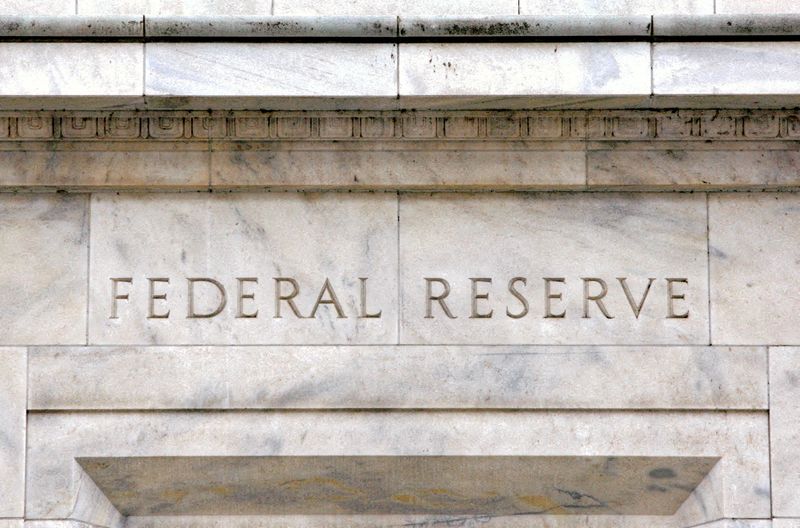By Mike Dolan
LONDON (Reuters) – Markets appear to have batted away next month’s Federal Reserve gathering as a paused ‘also ran’ meeting in favor of second-guessing about a November rate hike – but next month may hold the key to finally unlocking the end of the tightening cycle.
Fed Chair Jerome Powell was almost brusque in his re-statement of the central bank’s anti-inflation commitment at the annual Jackson Hole symposium on Friday. Without a significant new policy twist, his doggedness about the job at hand finally seemed to hit home.
After an edgy few weeks of repricing – as the U.S. economy re-accelerated in July and forced a reassessment of the long-term sustainability of the new higher interest rate regime – traders seem to finally agree with what policymakers have been saying since June: there’s one more hike to come.
For the first time since the SVB bust and regional bank crisis in early March, futures markets moved briefly this week to show as much as a 60% chance on another policy rate rise to the 5.50-5.75% range by the November 1 Fed meeting.
While that’s an ever-moving feast – and the ‘data dependency’ of the situation was illustrated by a quick recoil in that implied rate after Tuesday reports of ebbing consumer confidence and job vacancies – it shows markets far more in synch with Fed thinking on its peak ‘terminal rate’.
For all but six weeks of the entire year to date, the so-called ‘median dot’ – taken from the range of Fed policymakers yearend rate projections each quarter – has indicated an end-2023 rate in excess of where Fed futures rates put them.
DON’T FIGHT…
That thinking was of course bamboozled by the March banking upheaval – which suggested to many at the time that the lagged effects a year of Fed rate rises on credit were already hitting hard via bank stress. But even if credit creation has indeed slowed sharply, falling inflation, persistently tight labor markets and rising real wages have buoyed demand nonetheless.
So much so that the Atlanta Fed’s real time GDPNow estimate of real, inflation-adjusted U.S. economic growth in the current quarter had accelerated to some 5.9% as of last week – its highest since January last year and some 9% in nominal terms despite more than 500 basis points of Fed tightening in the interim.
Impressively, Fed officials never reduced the median year-end projection during all the market doubts of the spring – having only raised it half a point to 5.6% as the crisis unfolded in March. Tracking that rather than more-skittish policy rate futures would have proved a better guide to how subsequent months panned out and to the summer doldrums in bonds and stocks.
But because investors assume the Fed will want to see another couple of months of incoming economic reports before making a decision on whether it’s done already or not, futures now assume any additional move will come on November 1 and not the September 20 meeting – which appears to be sidelined in thinking as a ‘dead rubber’ where the Fed will pause to lap up more data.
And yet the September meeting could still be the ‘big reveal’ as it sees publication of the Fed’s updated ‘dot plot’ that will likely show just where they then see the cycle crest.
Given the Fed’s own accuracy so far this year in parsing the pathway and its faith in the economic resilience through the spring, that forecast will pack a punch.
Standing pat confirms the coagulating picture – another hike in the median dot could pre-empt two more to close the year that hoves a 6% rate into view all of a sudden.
And given all this month’s bond market angst about ‘higher-for-longer’ rates, the Fed’s existing median assumption of a 130bp drop in policy rate to 4.3% through 2024 may also be revised sharply to show a shallower decline – if any at all.
ACCIDENT OR DESIGN?
So has a seer-like Fed now got the market eating from its hand at last? Or is it just good at guessing itself and basically lucky on the real economy?
San Francisco Fed researchers Andrew Foerster and Zinnia Martinez last week made the case that disagreement among Fed policymakers – which had been falling after 2010 and was negligible during the pandemic – is on the rise again as views on the underlying strength of the economy and stickiness of inflation widen.
Developing an ‘index of disagreement’ based on the dispersion of ‘dot plot’ rate forecasts in the Fed’s quarterly updates, they show a wider array of views beyond the current year take – but clearly on the rise on one- and two-year horizons.
So less crystal-clear clarity and certainty that it appears.
As to whether the Fed is guiding everyone to safe and happy place, there continues to be sceptics about the ‘soft landing’.
“Business cycles are dynamic and avoiding recession this year does not, by itself, increase confidence that a long expansion is in the offing,” JPMorgan economists Bruce Kasman and Joseph Lupton told clients in a deep dive this week.
The JPM economists said there have been no historical precedents for sustained economic expansion following large and synchronised tightening across developed economies – although there have been three episodes since 1960 in which U.S. growth has been sustained for three or more years after a singular Fed hiking campaign of at least 2.5 percentage points.
For the U.S. to ape those past successes, they conclude, business hiring has to continue to hold in the face of slowing profits, the Fed has to be prepared to ease within six months of the last hike – which now seems unlikely – and a new supply-side growth impulse is likely needed as a tailwind.
No victory laps just yet, then.
The opinions expressed here are those of the author, a columnist for Reuters.
